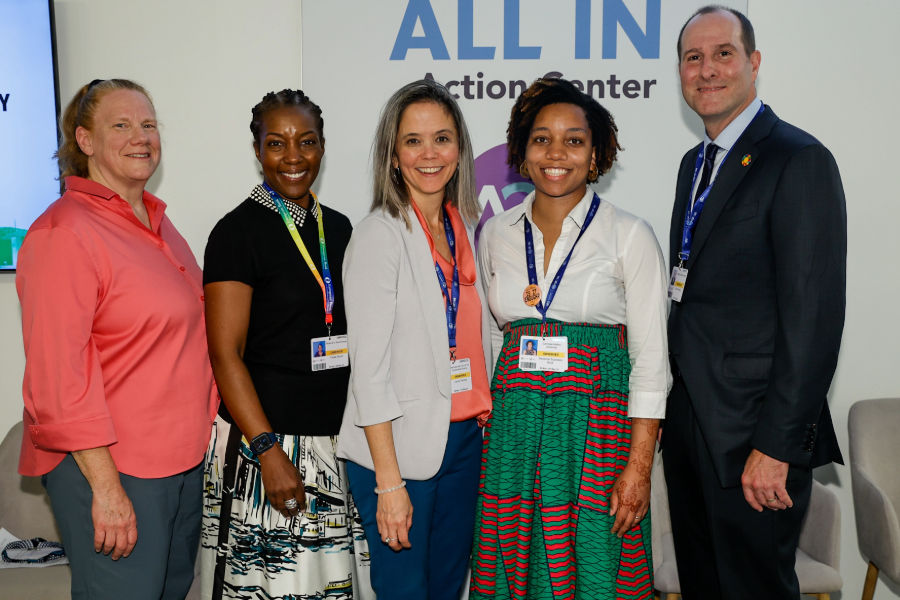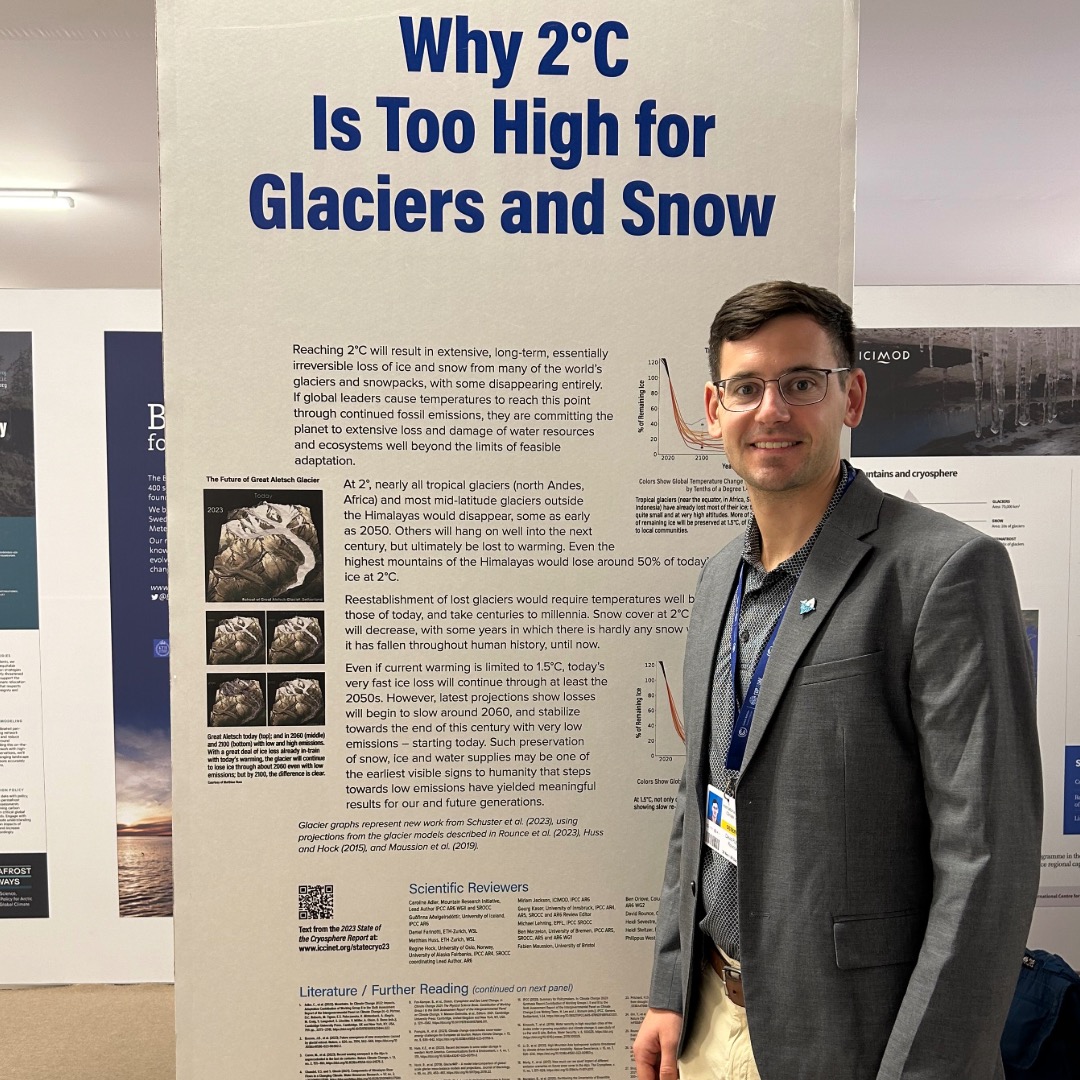
CEE at COP28: Energy Justice and Glacier Projections
From November 30 to December 12, 2023, two Civil and Environmental Engineering (CEE) professors, Destenie Nock and David Rounce, presented at one of the largest and most important international gatherings of the year.
The 28th annual United Nations Climate Change Conference, or COP28, is the world’s premier climate change convocation and brings together over 70,000 delegates, including lawmakers, business leaders, climate scientists, and other stakeholders, to address issues related to the climate crisis. Nock and Rounce shared their expertise with fellow thought leaders on topics such as energy efficiency, climate mitigation, mountain glaciers, global temperature rise, and more.
On a panel titled “Saving Energy, Saving Lives,” co-hosted by the Business Council for Sustainable Energy, Dr. Destenie Nock shared insights on the importance of energy efficiency in reducing emissions, limiting financial strain on households, and driving economic growth.
Nock’s recent research has focused on the intersection of energy use, poverty, and household income, specifically the gap in temperatures at which various households turn on their air conditioning (AC) and/or heating units.
Her data showed that low-income groups wait five to seven degrees longer than high-income groups to turn on their AC. The opposite occurs in the winter, where low-income groups utilize their heating systems six to ten degrees earlier than high-income groups. She hypothesizes that this difference is most likely the result of poor insulation within houses in low-income communities, as well as people being intrinsically more heat-tolerant than cold-tolerant. Moving forward, she hopes to analyze the resulting problems—are low-income families at higher risk of freezing their pipes in the winter? Or heat stroke in the summer?—and if energy efficiency could be the solution.
Aligning with Nock’s expertise, the panel dug into the socioeconomic perspective on energy efficiency, with speakers detailing personal anecdotes of lives that have been changed through access to heating and cooling systems. In sharing, Nock highlighted inconsistencies in the communities targeted for energy-efficient appliance deployments and who might be missed when identification methods rely solely on bill costs.
“If you spend a lot of money, then the utility company will target you to lower your bill with energy-efficient appliances,” she explained. “But when I lived in Massachusetts, we would turn off our heat every day before leaving for work to save money. Our landlord eventually noticed and told us that if the pipes froze, we would be liable. Our solution was to turn on the heat and pay that bill instead of our electricity, because we couldn’t afford both at the same time.”
“So when we ask, ‘What is energy efficiency?’ I think it’s helping people who are risking health issues, struggling to pay their bills, close to losing their home, or putting themselves in harm’s way, adapt to climate change,” Nock said. “Energy efficiency is not just a climate mitigation unifier. It’s also a climate adaptation unifier.”
“Energy efficiency is not just a climate mitigation unifier. It’s also a climate adaptation unifier.”
The session concluded with a discussion of public policy, where Nock reconsidered the ways in which our government incentivizes energy efficiency adoption. She explains that in some states, gas and electric companies are prohibited from encouraging anyone to utilize more energy in their homes.
“That sounds good for energy efficiency because you encourage people to use less, right?” She asked. “But when I went to a utility company requesting to deploy heat pumps to households without air conditioning, they said they can’t encourage anyone without air conditioning to get a heat pump because they would use more energy, and that would be bad for energy efficiency.”
Nock disagreed with this approach. “From an engineering perspective, the definition of energy efficiency is using less energy for the same quality of life,” she said. “Deploying heat pumps is not inherently inefficient if our communities are happier, healthier, and more productive than before.”
These inconsistencies are prevalent throughout the country, and Nock is working to shed light on the issues and work towards solutions. She returned from COP28 reinvigorated to continue her research and answer the question, how do we make clean energy more affordable?
 On the other end of COP28, the International Cryosphere Climate Initiative (ICCI) sponsored CEE Professor David Rounce to serve as an expert on all things mountain glaciers. Specifically, Rounce weighed in on the impact of glaciers under various temperature change scenarios, including estimating their contributions to sea-level rise, water resources, and the long-term effects glacial mass loss can have on our communities.
On the other end of COP28, the International Cryosphere Climate Initiative (ICCI) sponsored CEE Professor David Rounce to serve as an expert on all things mountain glaciers. Specifically, Rounce weighed in on the impact of glaciers under various temperature change scenarios, including estimating their contributions to sea-level rise, water resources, and the long-term effects glacial mass loss can have on our communities.
In his talk on global glacier loss projections, Rounce also discussed his contributions to the 2023 State of the Cryosphere Report, which warns that all of the planet’s frozen parts will experience disastrous damage with a 2°C increase in temperature. He offered new projections through 2300, forecasting unsustainable sea-level rise and devastating global effects if current emission levels persist, including water scarcity—affecting agriculture, food security, energy production, and human water sources—increased risks of landslides, ice shears, floods, and more.
Rounce also reviewed the report's section on mountain glaciers and snow, which suggests that even today’s 1.2°C climate is too warm for some of the Earth’s glaciers, which will be lost even if temperature rise somehow ceased tomorrow. If “very low” emissions were achieved by 2030, meaning a 40% decrease in fossil fuel emissions and a 1.6°C temperature, ice loss would still persist rapidly through the 2050s. However, at these “very low” levels, projections show the loss could slow in some regions by 2060, plateau by the end of the century, and even experience slow regrowth starting in the 2100s. Consequently, 2°C would result in extensive ice loss to many of the world’s glaciers and cause wide-spread, catastrophic damage.
In addition to the State of the Cryosphere Report, Rounce also contributed to the publication 10 New Insights in Climate Science within the section on glacier loss. This seventh insight characterizes mountain glaciers as highly sensitive indicators of climate change—even more so than ice sheets—and contributors to nearly one quarter of current sea-level rise.
In many regions of the world, the authors note, glaciers possess enormous social and economic value. Mountain ecosystems rely on glaciers to recharge aquifers, provide drinking water, fuel agriculture and irrigation, sustain local biodiversity, and power fishing, shipping, and tourism businesses. It is these functions and threats of flash floods and water shortages that make new loss projections so alarming; experts report that glacial mass loss is approximately 12% greater than previously thought due to ice melt occurring below the water surface that was unaccounted for years prior. As a result, today’s estimates of total glacial loss stand between 26% (at +1.5°C) and 41% (at +4°C) of their current volume by 2100.
The contributions of CEE faculty at this year’s United Nations Conference of Parties were instrumental in shaping the conversations and decisions that came out of COP28. From energy efficiency and socioeconomic implications to mountain glaciers and global temperature rise, Destenie Nock and David Rounce’s expertise helped inform panel discussions, press conferences, international publications, and, ultimately, the world’s solutions to the tremendous challenges posed by climate change.